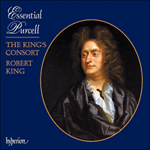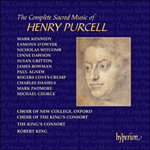Only one score of Hosanna to the highest survives, and this is a manuscript dating from after Purcell’s lifetime, but here, amongst all the church music, is one of the finest examples of a Purcellian ground bass. This one is four bars long, dropping first for four long notes, then returning to its tonic and rising for five: its simplicity and stark modality is hypnotic in the fifteen, slow-moving repetitions. Over this harmonic anchor a solo bass voice weaves its melodic spell, with Purcell treating the text, not in an extrovert manner, but with controlled, quiet ecstasy: from the outset we see that here is not an earthly marriage, but one far greater, conceived in heaven. The author of the text is unknown, but these are marvellously graphic words and sentiments which clearly stimulated the composer, for Purcell’s vocal writing is glorious, the tessitura of the solo bass creating sounds of great nobility. Everywhere we find marvellous word-painting and expressive harmony: the rising phrase ‘Let heav’n above’ contrasts with ‘Let earth triumph below’, the tongues are silenced with a long note, and ‘you rocks and stones’ are suitably gravely commanded ‘to break your flinty silence if men cease to speak’. The ‘sacred art’ is treated to rich harmony, and the word ‘plead’ is subjected to especially plaintive treatment.
After such rich sounds, the entry of a higher, second voice (at ‘Be ravish’d, earth’) is breathtaking: earth and heaven are linked in their ‘contract’, the two voices closely imitating each other’s phrases as the piece climaxes at ‘heav’n never showed so sweet a bridegroom, Nor earth so fair a bride’. Throughout his music Purcell rarely fails to beguile the listener with ravishing sounds, but here he brings to a close an example of his genius at its most startlingly original.
from notes by Robert King ©
Il ne reste qu'une seule partition de Hosanna to the highest et c'est un manuscript qui date de la vie de Purcell, mais ici et parmi toute la musique sacrée, nous avons l'un des plus beaux exemples de basse de fond de Purcell. Le fond est long de quatre barres de mesure, descendantes d'abord sur quatre notes longues puis revenant au tonique et remontant sur cinq; sa simplicité et sa modalité inflexible sont hypnotiques dans ses quinze répétitions lentes. Sur cette ancre harmonique, une voix soliste de basse tisse son charme mélodique; Purcell traite ici le texte non pas d'une manière extravertie mais avec extase, calme et contrôlée. Dès le départ nous pouvons voir qu'il ne s'agit pas d'un mariage terrestre, mais d'un mariage beaucoup plus grand, conçu au ciel. L'auteur du texte est inconnu mais ses mots merveilleusement graphiques et ses sentiments inspirent très certainement le compositeur: l'écriture vocale de Purcell est glorieuse, la tessiture de la voix soliste de basse possède une grande noblesse. Nous trouvons partout des mots merveilleusement colorés et une harmonie expressive: la phrase ascendante 'Let heaven above' (laisse le ciel là-haut) contraste avec 'Let earth triumph below' (Laisse la terre triompher ici-bas), les langues sont réduites au silence par une longue note et 'you rocks and stones' (vous pierres et rochers) sont instruits avec la gravité voulue de 'to break your flinty silence if men cease to speak' (rompre votre dur silence si les hommes cessent de parler). Le 'sacred art' (l'art sacré) est traité en une riche harmonie et le mot 'plead' (supplié) est soumis à un traitement particulièrement plaintif. Après des sons si riches, l'entrée d'une deuxième voix beaucoup plus haute (à 'be ravish'd, earth' [terre, sois transportée de joie]) est absolument ahurissante: la terre et le ciel sont unis par leur 'contrat', les deux voix imitant chacune de.près la phrase de l'autre dans une riche harmonie alors que le morceau atteint son point culminant à 'heav'n never show'd so sweet a bridegroom, nor earth so fair a bride' (le ciel n'a jamais vu si gentil marié ni la terre si belle mariée). A travers toute sa musique, Purcell manque rarement de séduire l'auditeur avec des sons ravissants mais ici il met le point final à un exemple de sa musique sous sa forme la plus formidablement originale.
extrait des notes rédigées par Robert King © 1992
Français: Martine Erussard
Von Hosanna to the highest ist nur eine Partitur überliefert, ein Manuskript, das nach Purcells Lebenszeit datiert ist. Hiermit ist uns jedoch von der gesamten Kirchenmusik eines der besten Beispiel für den purcellschen Ground (Basso ostinato) gegeben. Dieser Ground besteht aus vier Takten, wobei er über vier lange Noten zuerst abfällt, dann zu seiner Tonika zurückkehrt und über fünf Noten ansteigt — seine Simplizität und starke Modalität wirkt mit seinen fünfzehn langsamen Wiederholungen fast hypnotisierend. Um diese harmonische Stütze schlingt eine Baßsolostimme ihren melodischen Zauber, wobei Purcell den Text nicht in großzügiger Weise behandelt, sondern mit disziplinierter, ruhiger Verzückung. Schon von Anfang an wird klar, daß hier keine irdische Hochzeit vorliegt, sondern ein größerer, im Himmel geschlossener Bund. Der Verfasser des Textes ist unbekannt, doch wurde der Komponist durch die darin enthaltenen Darstellungen und Empfindungen deutlich beflügelt: Purcells Vertonung ist großartig, das Tessitura des Baßsolos erzeugt ungemein edel klingende Töne. Wunderbare Wortmalereien und ausdrucksvolle Harmonien sind überall zu finden, die ansteigende Phrase 'Let heaven above' (Laß den Himmel hoch oben) wird mit 'Let earth triumph below' (Laß die Erde unten frohlocken) gegenübergestellt, die Zungen werden mit einer langen Note zum Verstummen gebracht, und den 'rocks and stones' (Felsen und Steine) wird mit ernster Stimme geboten, 'to break your flinty silence if men cease to speak' (ihre steinige Stille zu brechen, wenn Menschen nicht mehr sprechen). Die 'sacred art' (heilige Kunst) wird mit reichhaltigen Harmonien ausgestattet, und dem Wort 'plead' (bitten) wird eine besonders klagende Behandlung gegeben. Nach einer solchen Klangfülle ist der Einsatz einer viel höheren zweiten Stimme (bei 'be ravish'd, earth' [sei entzückt, Erde]) überwältigend: Erde und Himmel werden verbunden, die Stimmen ahmen in schöner Harmonie jeweils die Phrasen der anderen nach und das Stück erreicht seinen Höhepunkt mit 'heav'n never show'd so sweet a bridegroom, nor earth so fair a bride' (der Himmel besaß noch nie einen solch gütigen Bräutigam, noch die Erde eine solch schöne Braut). In seiner gesamten Musik gelingt es Purcell immer, den Zuhörer mit entzückenden Klängen zu bezaubem, doch hiermit schließt ein Beispiel ab, bei dem seine Musik überdurchschnittlich originell ist.
aus dem Begleittext von Robert King © 1992
Deutsch: Meckie Hellary


 Essential Purcell
Essential Purcell Purcell: The Complete Sacred Music
Purcell: The Complete Sacred Music
